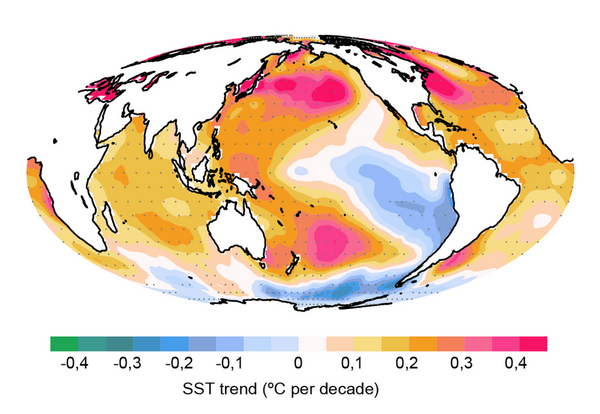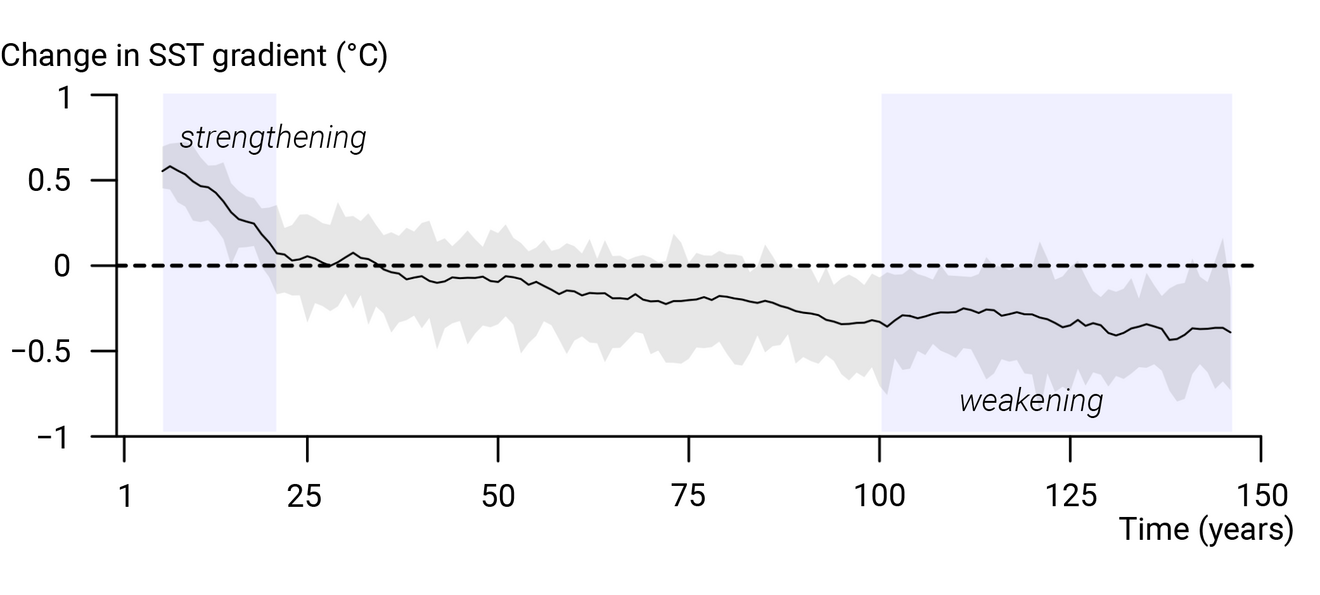A puzzling temperature pattern in the tropical Pacific

Sometimes, places that are far apart are still deeply connected. A good 15,000 kilometers separate the eastern border of Indonesia from Ecuador in South America. Between the two countries lies the vast Pacific Ocean that is, however, not just a divide, but an unparalleled link that connects not only Indonesia and Ecuador, but the entire planet. Examples of this are the weather phenomena El Niño and La Niña. During these phenomena, atmospheric and oceanic currents in the tropical Pacific deviate from the normal situation—with noticeable consequences around the world.
Normally, the western tropical Pacific is warmer than the eastern Pacific. The fact that the trade winds drive water masses westward allows upwelling of cooler deep water off the west coast of South America, leading to a region that is known as the Pacific Ocean Cold Tongue. In the atmosphere, warm, moist air ascends above the western Pacific, and cooler, dry air sinks above the eastern Pacific. The near-surface equatorial trade winds complete the cycle.
Every two to seven years, an El Niño event turns these rules of tropical Pacific circulation upside down. The equatorial trade winds weaken, the upwelling of deep water is inhibited, and the water temperature in the eastern Pacific increases. Such years are exceptionally warm globally—as was the case in the record-breaking year of 2023. El Niño also promotes extreme weather: It rains more than usual on the west coasts of South America and the US, while Indonesia, South Africa, and Australia can experience drought. The situation is reversed in the “La Niña” phenomenon that often follows: The Walker circulation strengthens, the temperature gradient between the western and eastern Pacific rises above normal levels, and while Southeast Asia is hit by heavy rainfall, there is less rain in South America.

Reaction of the tropical Pacific to global warming
Researchers suggest that global warming favors particularly strong El Niño events—some even warn of an increase in “super El Niños.” Both theoretical considerations and modeling studies support this view, indicating that the Walker circulation will weaken overall in the long term, temperatures in the eastern Pacific will rise, the east-west temperature gradient in the tropical Pacific will decrease, and the Cold Tongue will become less pronounced. While most scientists agree on this, the reality looks quite different.
Observational data from satellites, ships, and buoys show that the eastern Pacific has not warmed over the past 45 years, but has actually cooled! The temperature gradient between the western and eastern Pacific has not become weaker but stronger. And according to atmospheric measurements, the Walker circulation has not slowed down but intensified. Rather than El Niño, La Niña appears to be the climate system's response to global warming.
Discrepancies between observations and models
So it is not only Indonesia and Ecuador that are far apart, but also expectations and reality in the tropical Pacific. This mismatch between model projections and observed trends raises a critical question about the reliability of future climate projections. This discrepancy is more than a scientific curiosity; it represents one of the big puzzles in climate research. At stake is not just whether El Niño or La Niña-like conditions will dominate in the future. The temperature pattern in the tropical Pacific strongly influences how much the planet will warm in response to a certain amount of carbon dioxide (CO2) increase. The tropical Pacific therefore plays a decisive role in determining the overall extent of global warming. Closing the gap between models and observations in this region is thus crucial for improving the accuracy of long-term climate projections.
The working group of Sarah Kang, Director at the Max Planck Institute for Meteorology (MPI-M) and head of the Climate Dynamics department, is investigating the tropical Pacific's response to climate change.
“Now is exactly the right time to look into this question,” says Kang. “We are already feeling the effects of climate change, and at the same time we now have observations over a sufficiently long period of time to document the effects of global warming.”
Sarah Kang, Masahiro Watanabe from the University of Tokyo, and MPI-M researcher Veronika Gayler unraveled the mystery of the Walker circulation through targeted experiments with an atmospheric general circulation model. By varying the intensity and pattern of sea surface warming, they identified two opposing effects that determine the strength of the Walker circulation: As expected, globally uniform warming causes a weakening of the Walker circulation. However, the observed pattern of sea surface temperatures, featuring a stronger east-west gradient with a warm western Pacific and cool eastern Pacific, has a reinforcing effect. At present, this reinforcing effect dominates.

Teleconnections previously underestimated
But why is the temperature pattern in the tropical Pacific the way it is? Why has the eastern tropical Pacific cooled in recent decades despite global warming? For a while, it was unclear whether this was only due to natural climate fluctuations. However, the observations now show a clear long-term trend which cannot be explained by internal variability alone. So what are its physical causes? Climate models do not provide an answer:
“The fact that the models cannot reproduce the temperature pattern shows that the underlying processes are not properly represented in models,” says Kang.
Together with Watanabe and other colleagues, she evaluated 150 scientific studies. The researchers identified several mechanisms that lead to a cooling of the eastern Pacific. These extend around the entire globe and range from aerosol emissions from the continents of the northern hemisphere all the way to the Southern Ocean.
Using climate simulations, the researchers showed that the unusually cold Southern Ocean in recent decades may have contributed to the cooling of the eastern tropical Pacific. The origin of this Southern Ocean cooling remains uncertain, but potential explanations include Antarctic meltwater, which is absent in current generation of climate models, and multi-decadal natural variability within the Southern Ocean itself. The inability of models to capture this Southern Ocean cooling helps explain their poor performance in reproducing the observed cooling trends in the eastern tropical Pacific.

Different reactions depending on the time horizon
More recently, Sarah Kang and colleagues have raised a fundamental question: Is it appropriate to invoke the long-term climate response to explain recent observations, which have been made in the transient period we are currently experiencing? The response of the climate system to increasing CO2 can be divided into an initial adjustment phase and the long-term, new equilibrium. If they are distinct, then the observed patterns during the transient period will naturally diverge from the long-term response.
To explore this, the team conducted large-ensemble simulations, i.e. a large number of similar simulations with slightly different initial conditions, of a sudden quadrupling of atmospheric CO₂. This experiment was designed to isolate the fast response from the slower, gradual adjustment. Their initial results reveal a distinct fast response that evolves differently from the long-term behavior. For example, MPI-M researcher Jiayu Zhang showed that the Intertropical Convergence Zone (ITCZ)—a key equatorial rain band—initially becomes wider and weaker in response to the sudden CO₂ increase, but later narrows and intensifies as the system equilibrates. Similarly, MPI-M scientist Dirk Olonscheck found that the zonal sea surface temperature gradient across the tropical Pacific initially strengthens before transitioning into the familiar weakening pattern associated with long-term warming. Using more than 200 ensemble members, MPI-M scientist Eduardo Moreno-Chamarro demonstrated that this transition is a robust feature across simulations.

Understanding the transition
What drives this transition? A key candidate is the rapid warming of land relative to the ocean—one of the most prominent fast responses to increased CO₂. To test this, MPI-M researcher Moritz Günther performed targeted experiments with an idealized configuration: CO₂ was quadrupled only over land. Although unrealistic, this setup provides valuable insight. The land-only CO₂ quadrupling led to cooling in the eastern tropical Pacific, suggesting that land warming can induce atmospheric circulation changes that promote equatorial upwelling. Further regional experiments identified contributions from northern extratropical landmasses, tropical land, and South America, all of which can trigger circulation changes that help cool the eastern Pacific.
While these processes are temporary, climate scientists' expectations that an El Niño-like condition will dominate in the future are likely to prove correct in the long term. Recent research by Kang and colleagues from the US, UK, and South Korea suggests that delayed Southern Ocean warming contributes to this El-Niño-like warming, which is further linked to intensified monsoon rainfall in East Asia and wetter winters in the western United States.
The crucial question of when the transition from the current cooling of the eastern Pacific to warming will take place is also being worked on intensively in Kang's department. To this end, Kang has used scenarios in which atmospheric CO₂ increases by 1% per year. By decomposing the response in these scenarios into fast and slow components—based on those identified in abrupt CO₂ quadrupling experiments—the transition is projected to occur when CO₂ concentrations double. With current CO2 levels already about 40% above preindustrial values, this implies the transition could take place within the next three to four decades. However, the precise timing remains uncertain due to the continued influence of aerosol forcing, which significantly affects near-term climate responses.
The question of the tropical Pacific warming pattern thus remains a major challenge in climate science, as multiple mechanisms operate on different timescales. Unraveling the processes behind this complex system has deepened scientists’ understanding of how the climate system functions as an interconnected whole. It is a field full of challenges—but equally full of opportunities.
Further information
Department of Climate Dynamics
TROPICS
Original publications
Kang, S. M., Watanabe, M., & Gayler, V. (2025). Common and distinct drivers of convective mass flux and Walker circulation changes. Geophysical Research Letters, 52, e2024GL111897. DOI: 10.1029/2024GL111897
Kim, H., Kang, S.M., Pendergrass, A.G. et al. Higher precipitation in East Asia and western United States expected with future Southern Ocean warming. Nature Geoscience (2025). DOI: 10.1038/s41561-025-01669-5
Watanabe, M., Kang, S.M., Collins, M. et al. Possible shift in controls of the tropical Pacific surface warming pattern. Nature 630, 315–324 (2024). DOI: 10.1038/s41586-024-07452-7
Contact
Prof. Dr. Sarah Kang
Max Planck Institute for Meteorology
sarah.kang@mpimet.mpg.de
Dr. Moritz Günther
Max Planck Institute for Meteorology
moritz.guenther@mpimet.mpg.de
Dr. Eduardo Moreno-Chamarro
Max Planck Institute for Meteorology
eduardo.chamarro@mpimet.mpg.de
Dr. Jiayu Zhang
Max Planck Institute for Meteorology
jiayu.zhang@mpimet.mpg.de
